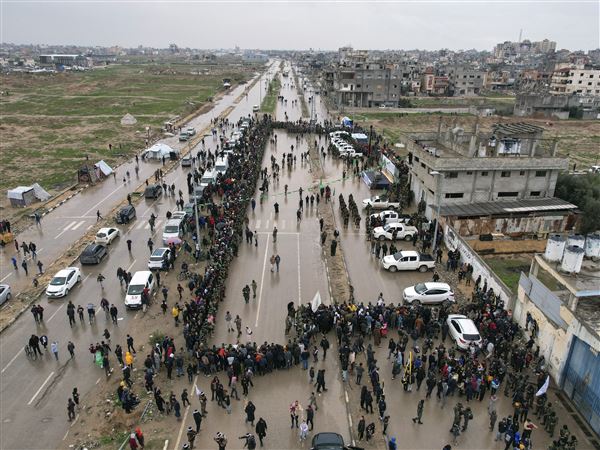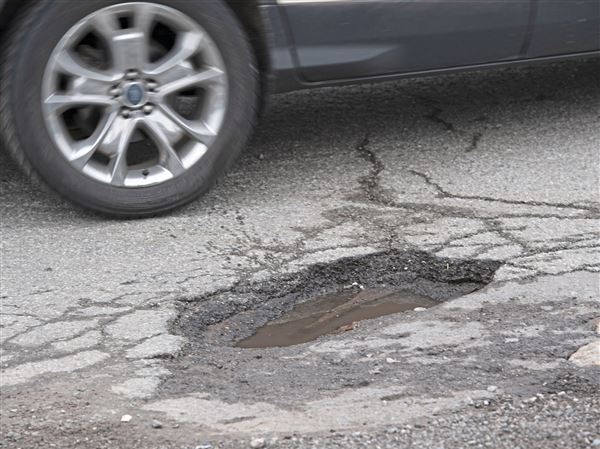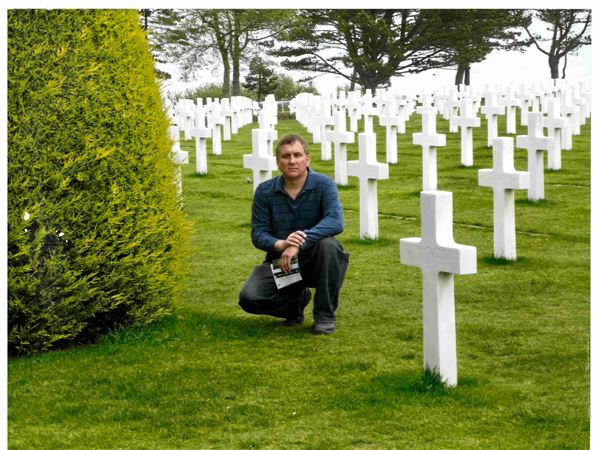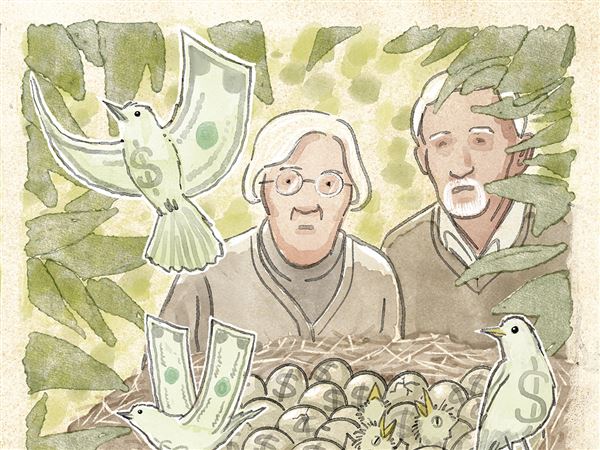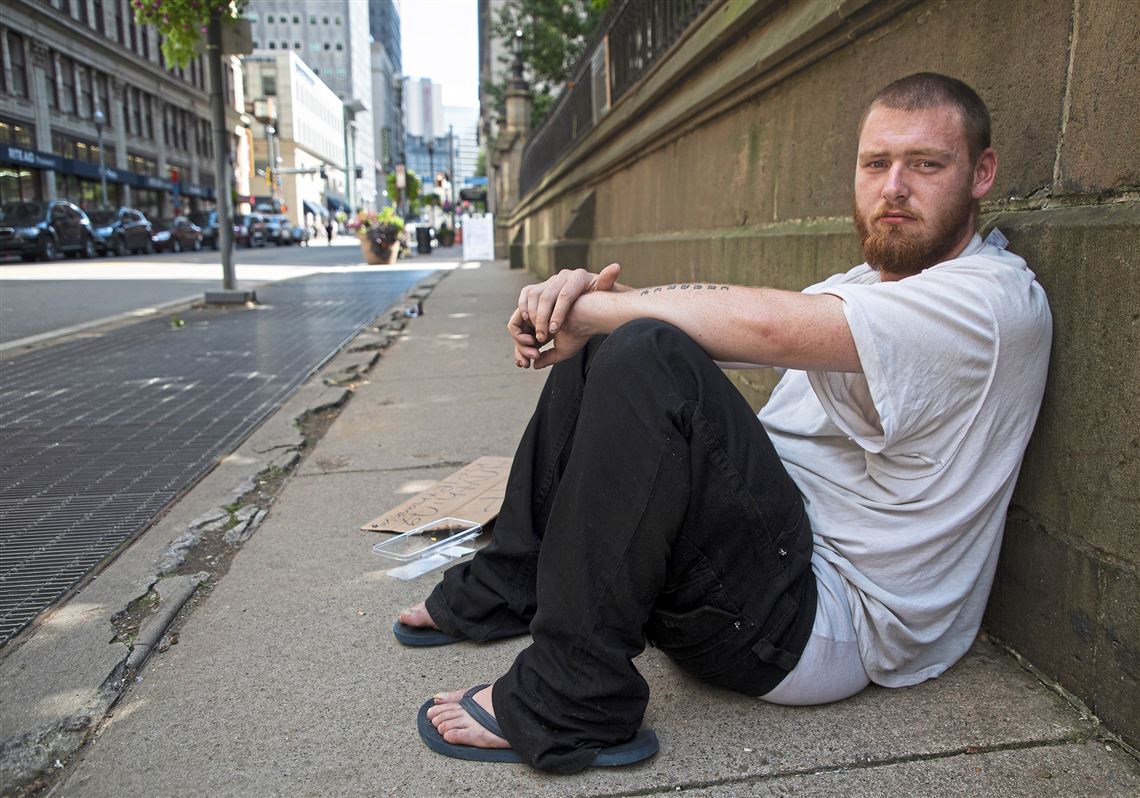Part one of two: This is the first of a two-part series on homelessness in Downtown Pittsburgh. Read part two on Sunday.
“NEED helP Anything help thank you.”
The message, scrawled in black marker on the cardboard sign beside 21-year-old David McClung, summed up his current situation: homeless, panhandling and sure he’d be back on his feet again someday.
“It’s not permanent,” he said, sitting on a Downtown sidewalk with his back against a concrete retaining wall. “It’s temporary.”
He follows some self-imposed rules for panhandling and doesn’t call out or approach the people who pass him by.
“I don’t beg,” he said. “I just sit with the sign. If they give, they give, and if they don’t, they don’t.”
Mr. McClung sat a stone’s throw away from a bus stop on Sixth Avenue where a homeless woman was stabbed to death weeks earlier. The attack was one of several stabbings in Downtown that — coupled with a weeks-long back and forth between some Downtown business owners and city officials — brought attention to the issues of homelessness, crime and panhandling in the city’s center.
Kevin McMahon, CEO of the Pittsburgh Cultural Trust, wrote in a July letter to Mayor Bill Peduto that his organization had seen an increase in homelessness, aggressive panhandling, disorderly youth, people under the influence and other nuisances in Downtown during the last year.
But despite that perceived uptick, city and county data show Downtown crime has remained steady for three years and is on pace to be lower in 2019 than 2018.
Similarly, countywide point-in-time counts show homelessness has declined during the last three years, and the county’s street outreach teams are on track this year to serve either the same or slightly fewer people than in 2018.
So far this year, Downtown has seen an increase in assaults and rapes when compared to the previous five years, with 33 reported assaults and 9 rapes in the city center, according to a report released Thursday by Pittsburgh police. But overall instances of Part I crimes — murder, rape, robbery, assault, burglary, theft, vehicle theft and arson — are lower this year than in the same eight-month periods in 2014 through 2018, according to the report.
During the last five years, on average there were 531 Part I crimes reported between January and August in Downtown. This year, there were 506 reported, according to police.
Total crime in Downtown, including property crime, has hovered between 1,600 and 1,800 incidents annually since 2014; year-to-date numbers show 2019’s crime appears to be on pace to fall in that range.
In the wake of the discussions about problems Downtown, local experts said homelessness, panhandling and crime are separate issues that are often mistakenly viewed as one problem. Many panhandlers are not homeless, they said, and homeless people are more likely to be victims of crime than perpetrators.
"We do know that not all the individuals who are being pointed to as homeless are actually homeless," said Abigail Horn, Allegheny County Department of Human Services deputy director of the Office of Community Services.
None of the four men arrested for stabbings in Downtown Pittsburgh in August were homeless, according to court documents. The only fatal stabbing claimed the life of a homeless woman who was sitting at a bus stop.
“This absolutely has nothing to do with housing,” said Charlie Chapman, executive director of Living Ministry, a North Side nonprofit that serves the homeless. “How does housing stop violence? It doesn't.”
There is a tendency among those who don’t frequently work with homeless people to perceive even those who aren’t homeless as homeless, Mr. Chapman said, which can contribute to harmful stereotypes.
“There are a lot of people who hang outside. And because they hang outside they’re ‘homeless,’” he said. “So whatever they are doing, let’s say they eat at [a shelter], they’re then ‘homeless’ even though [the shelter] feeds whoever wants to come.”
The same holds true for panhandlers, many of whom are not homeless, he said.
There is overlap between the groups, and homelessness is often linked with other underlying issues, like addiction, abuse, trauma or mental health.
“Not enough people understand that these aren’t people who are lazy,” said Becky Haberstroh, director of youth and family services at Familylinks, which operates three shelters in the county. “These are people who have had significant trauma in their lives. These are people that have experienced things that neither you nor I have ever experienced in life or can imagine.”
As people walked by his spot on the sidewalk on Sixth Avenue on a recent Wednesday afternoon, Mr. McClung shared some detail about how he’d ended up there.
He said he’d come to the city from West Virginia for job training in 2017, but hadn’t found work when the program was over. He was on the streets for a bit, then placed in housing in McKeesport, but was evicted.
Back on the streets, sleeping on church steps, he picked up occasional work on construction sites and could usually panhandle enough money to buy a meal or two each day.
Three days earlier, he’d been released from the Allegheny County Jail, where he’d been incarcerated for five days after he missed a court date in a trespassing case.
Court records showed he’d been charged with trespassing in February after he’d tried to stay at an ex-girlfriend’s home in Wilkinsburg; he’d been jailed for 12 days then because police didn’t have an address to send his court paperwork to and because he couldn’t come up with $200 for bail.
In May, Mr. McClung pleaded guilty to public drunkenness, and was given 60 days to a pay $459 in court costs — if he can’t pay, he’ll serve 10 days in jail, according to court records. So far, he’s paid $2, according to court records.
Mr. McClung said he’d go back to West Virginia if he could.
“At least there,” he said, “I won’t be getting into trouble with the law.”
In August, Mayor Peduto said the city would deploy additional police officers to Downtown in response to the spate of stabbings — which is an uptick from past years — and the complaints from business owners.
But he also said Downtown’s public safety issues can’t be solved by police alone, saying the problems were connected to homelessness, addiction and mental health.
“We’re not going to solve this problem simply by having police,” he said on Aug. 29, adding that homeless people will often gather in Downtown because they have easy access to services like shelter, food and showers.
Dr. Jim Withers, founder and medical director of Pittsburgh Mercy’s Operation Safety Net, which provides medical care and other services to homeless people, said arresting people for loitering or trespassing can unnecessarily land people in jail.
“To some degree, by targeting that, I think you’re criminalizing a situation that people are experiencing, especially people who are exhausted or don't have anywhere to sleep, and they just find a little place to curl up, and then they have to move on or get arrested for trespassing,” he said. “I do always feel that if someone is aggressive and threatening, that they have to be held accountable. So it’s really important to look at the behavior and address that appropriately.”
He and others advocated for an individualized approach to helping homeless people, and cautioned against painting the problem or its causes with broad strokes.
“We've realized, working with people and the diversity of their experience, that you have to almost adopt person-first model where you're looking at that individual,” said Dan Palka, outreach team leader for Operation Safety Net, adding he’s seen homeless people get housing but later end up back on the street because of other unmet needs.
“What outreach and homeless services aspire to do is meet people in a place where they dictate the terms of their recovery,” he said “And it's not super rapid. And it's not like a quick fix. But it's probably the most durable way to help people actually achieve progress in their life.”
In the nearly two decades that Dr. Withers has been working in Pittsburgh’s streets, he’s seen how neighborhoods sometimes rise up against homeless people, making life difficult for them until they move to another area.
Over the years, he’s seen the city’s homeless population be pushed from Downtown to the North Side, and from the North Side to the South Side.
“It's been a very migratory kind of a process to follow the folks that we try to help and serve and get off the street,” he said, adding later, “That’s created a real challenge. It feels like maybe the thing is going full circle again, and people are — and it's the summer, but people may be reinhabiting the city Downtown.”
Back where Mr. McClung was panhandling on Sixth Avenue, about 100 people gather once a week at First Presbyterian Church on Sixth Avenue for a free meal served by nonprofit Outreached Arms, said Rev. Tom Hall, senior pastor.
“We’ve been able to build a kind of community on Tuesday nights,” he said, adding that the goal is “loving people and walking with them.”
But he said the church has also for years struggled to deal with “people abusing the property overnight,” and said people sleep, use drugs, fight and defecate on the church steps.
The church about four months ago hired a roving security guard to move people away from the church steps several times during the night, Mr. Hall said.
“It moves off people who might have slept there otherwise and so the degrading behavior and defecation is not there,” he said. “But we’re also acutely aware the folks have been moved someplace else. It helps us with this one particular problem of the abuse of the property, but it’s not helping those folks.”
He added that he’s sure the number of people panhandling and overdosing in Downtown are higher than past years, and said it’s put the city “more on edge,” although he acknowledged that perception is based on anecdotal evidence, and said attendance at the church’s weekly dinners has remained steady through the years.
The number of fatal overdoses in Downtown and the Strip — the 15222 zip code — spiked in 2017 but dropped in 2018, according to data on the OverdoseFreePa website, run by the University of Pittsburgh’s School of Pharmacy.
There were six fatal overdoses in that zip code in 2016, 11 in 2017 and 4 in 2018, according to the site. Preliminary data for 2019 shows there have been fewer than three.
It can be difficult for those not involved with helping homeless people to see the progress that has been made in many individual cases, Dr. Withers said. Although there might be a constant presence of panhandlers and homeless people Downtown, the city’s homeless population is constantly changing, he said, as people move in and out of temporary homelessness.
“With the right services, we've housed thousands of people,” he said. “And if you talk to them now, you can hear stories of success, recovery, connecting with their family, you know, not not totally happily ever after -- these are people with really big problems -- but people who have a door that can lock at night and be safe. And business people don't see that, they don't see the thousands of people who were there [on the streets for] maybe at a window their life, but are now in a much better place. So I have empathy for the folks Downtown that just see this bit of humanity and think it's one blob — but it's actually hundreds and hundreds of people.”
Shelly Bradbury: 412-263-1999, sbradbury@post-gazette.com or follow @ShellyBradbury on Twitter. Kate Giammarise: kgiammarise@post-gazette.com or 412-263-3909.
First Published: September 13, 2019, 3:02 p.m.

